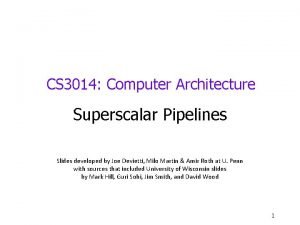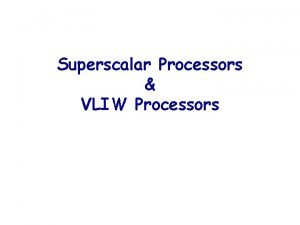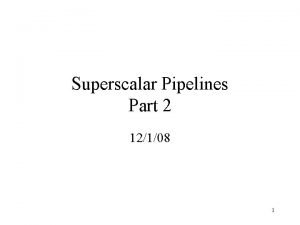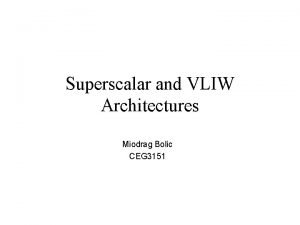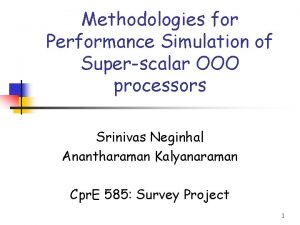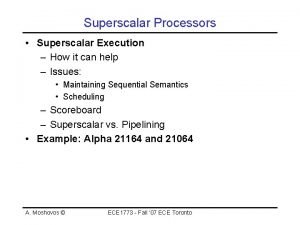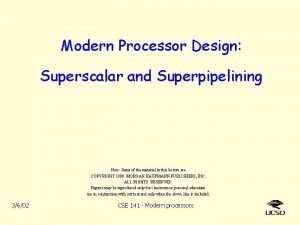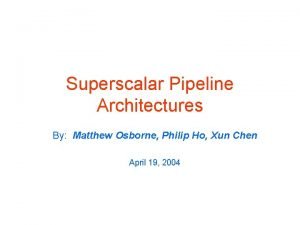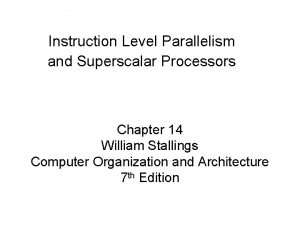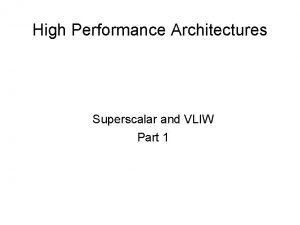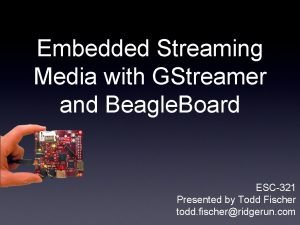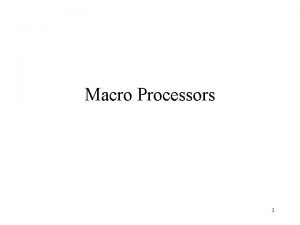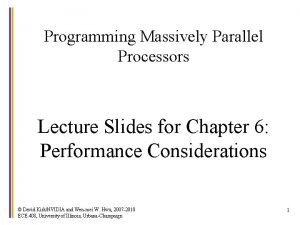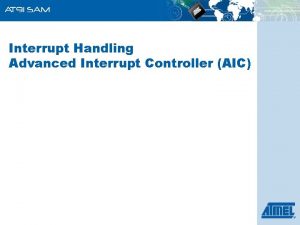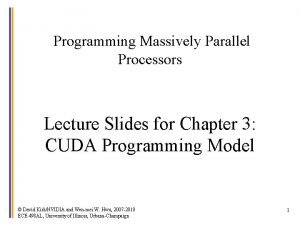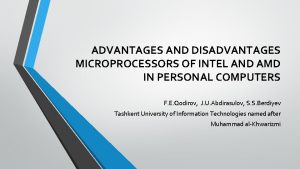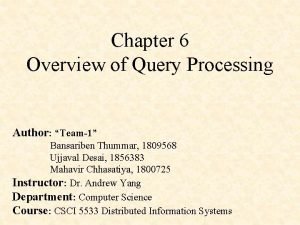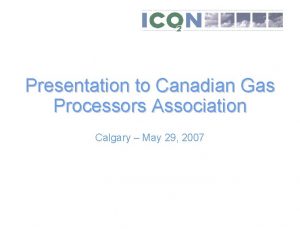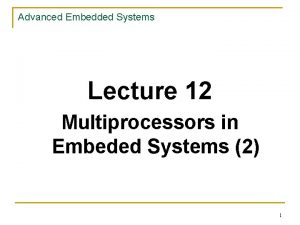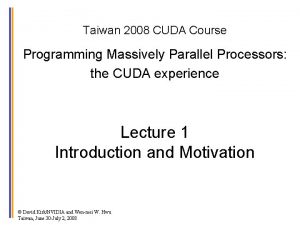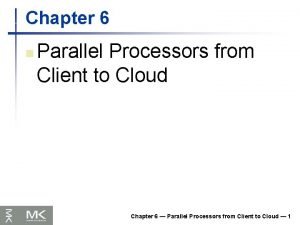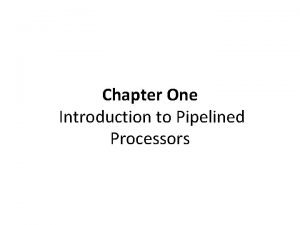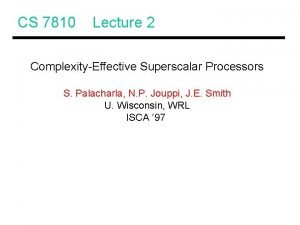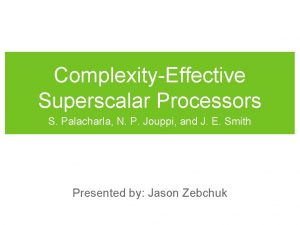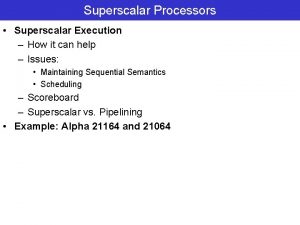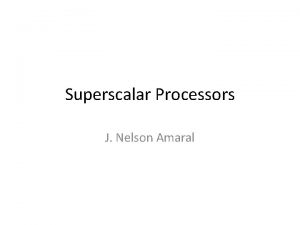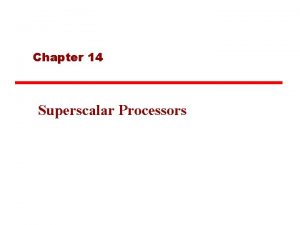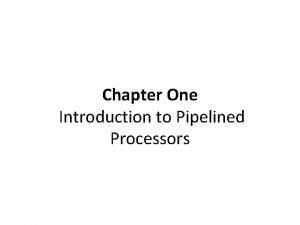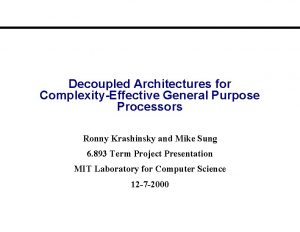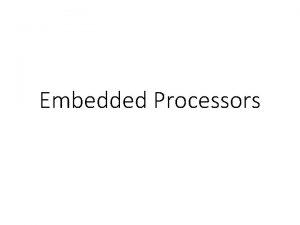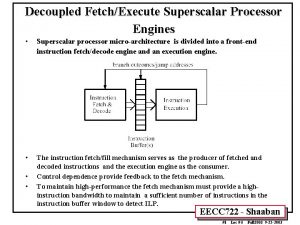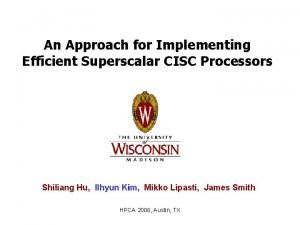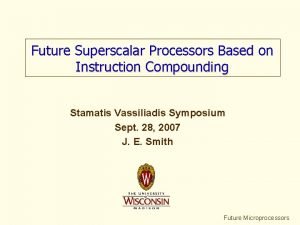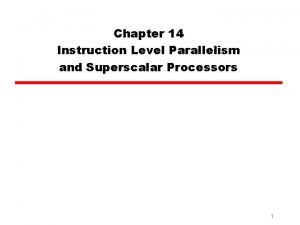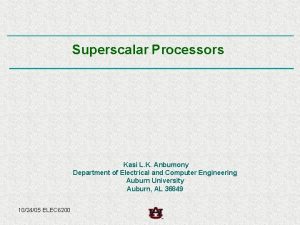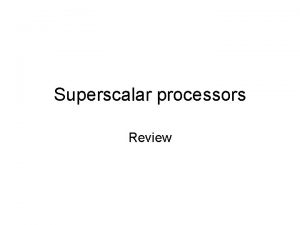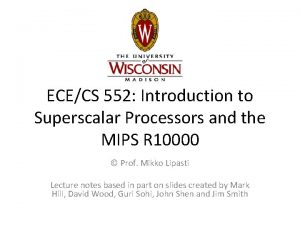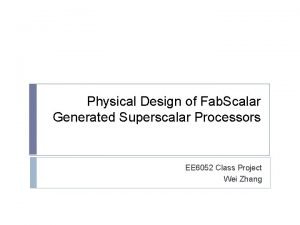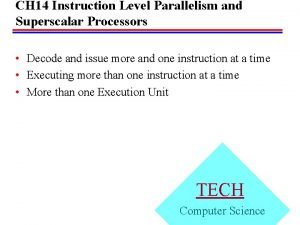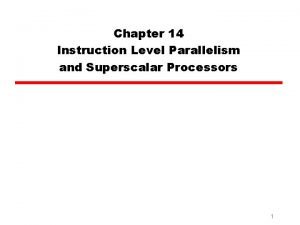CS 7810 Lecture 2 ComplexityEffective Superscalar Processors S


































- Slides: 34

CS 7810 Lecture 2 Complexity-Effective Superscalar Processors S. Palacharla, N. P. Jouppi, J. E. Smith U. Wisconsin, WRL ISCA ’ 97

Complexity-Effective • Conflict between clock speed and parallelism • Goals of the paper: Ø Characterize complexity as a function of issue width, window size, and feature size Ø Propose clustered microarchitecture that allows fast clocks with high parallelism

Current Trends (circa 1997) • More functional units, large in-flight windows • Impact on cycle-time critical structures Ø Register renaming Ø Instruction wake-up Ø Instruction selection Ø Result bypass Ø Register files Ø Caches

Wire Delay Trends • Logic delays scale linearly with feature size • Wire delay ~ RC = Rm x Cm x L 2 • Rm = r / (width x thickness) • Cm = 2 x e 0 x (thickness/width + width/thickness) • Rm ~ S ; Cm ~ S ; L ~ 1/S (gate size scaled by 1/S) • Hence, delay across 50 K gates is constant in ps and is linear with S in terms of FO 4

Update on Wire Delays • “The Future of Wires”, Ho, Mai, Horowitz, 2001 • Cm actually decreases with reduced feature widths • Hence, wire delay across 50 K gates (in FO 4) increases only slightly and is not quite linear with S – uses repeaters • Wire delays are still a problem (though, not as bad as Palacharla et al. claim) – also note, FO 4 s/clock is shrinking

Update on Wire Delays From “Future of Wires”, Ho, Mai, Horowitz

Register Rename Logical Source Regs Map Table Free Pool Logical Dest Regs Logical Source Reg Dependence Check Logic Physical Source Regs Physical Dest Regs Mux

Map Table – RAM 7 -bits Num entries = Num logical regs 7 -bits Phys reg id Shadow copies (shift register)

Map Table – CAM 5 -bits Num entries = Num phys regs Logical reg id 1 -bit v a l i d Shadow copies

Delay Model Wire length = C + 3 x IW cell Delay = RC = c 0 + c 1 x IW + c 2 x IW 2 Rename delay ~ IW The wire delay component increases as we shrink to 0. 18 m Problems: • They assume that wire delay/l (in ns) remains constant. • No window size?

Wakeup Logic tag 1 tag. IW … or = = or rdy. L tag. R rdy. R tag. L tag. R rdy. L . . . rdy. R

Wakeup Logic • CAM array wire length ~ issue width x winsize • Capacitive load ~ winsize • Matchline length ~ issue width • Issue width has a greater impact on delay as it influences tagdrive and tagmatch (the quadratic components are not very dominant) • For smaller features, the wire delays dominate

Selection Logic Issue window req anyreq grant enable Arbiter cell enable

Selection Logic • Multiple FUs are handled by having more stages in series – further increases selection logic delay • Delay ~ log(WINSIZE) • Wire lengths ~ WINSIZE, but are ignored – hence, delay scales very well with feature size

Bypass Delay • The number of bypass paths equals 2 x. IW 2 x. S (S is the number of pipeline stages) • Wire length ~ IW, hence, delay ~ IW 2 • The layout and pipeline depth (capacitive load) also matter

Summary of Results Issue Width Window Size Rename Wakeup + Delay (ps)technology Select 0. 8 mm (ps) 1577. 9 2903. 7 1710. 5 3369. 4 Bypass Delay (ps) 4 8 32 64 184. 9 1056. 4 0. 35 mm technology 4 8 32 64 627. 2 726. 6 1248. 4 1484. 8 184. 9 1056. 4 0. 18 mm technology 4 8 32 64 351. 0 427. 9 578. 0 724. 0 184. 9 1056. 4

Bottlenecks • Wakeup+Select and Bypass have the longest delays and represent atomic operations • Pipelining will prevent back-to-back operations • Increased issue width / window size / wire delays exacerbate the problem (also for the register file and cache)

Dependence-Based Microarchitecture r 3 r 1 + r 2 r 4 r 3 + r 2 r 5 r 4 + r 2 r 6 r 4 + r 2 r 7 r 6 + r 2 r 8 r 5 + r 2 r 9 r 1 + r 2 FIFOs Rdy Operands r 1 1 r 2 1 r 3 0 …

Dependence-Based Microarchitecture r 3 r 1 + r 2 r 4 r 3 + r 2 r 5 r 4 + r 2 r 6 r 4 + r 2 r 7 r 6 + r 2 r 8 r 5 + r 2 r 9 r 1 + r 2 FIFOs Rdy Operands r 3 r 1 + r 2 r 1 1 r 2 1 r 3 0 …

Dependence-Based Microarchitecture r 3 r 1 + r 2 r 4 r 3 + r 2 r 5 r 4 + r 2 r 6 r 4 + r 2 r 7 r 6 + r 2 r 8 r 5 + r 2 r 9 r 1 + r 2 FIFOs Rdy Operands r 4 r 3 + r 2 r 3 r 1 + r 2 r 1 1 r 2 1 r 3 0 …

Dependence-Based Microarchitecture r 3 r 1 + r 2 r 4 r 3 + r 2 r 5 r 4 + r 2 r 6 r 4 + r 2 r 7 r 6 + r 2 r 8 r 5 + r 2 r 9 r 1 + r 2 FIFOs r 5 r 4 + r 2 r 4 r 3 + r 2 r 3 r 1 + r 2 Rdy Operands r 1 1 r 2 1 r 3 0 …

Dependence-Based Microarchitecture r 3 r 1 + r 2 r 4 r 3 + r 2 r 5 r 4 + r 2 r 6 r 4 + r 2 r 7 r 6 + r 2 r 8 r 5 + r 2 r 9 r 1 + r 2 FIFOs r 5 r 4 + r 2 r 4 r 3 + r 2 r 3 r 1 + r 2 Rdy Operands r 6 r 4 + r 2 r 1 1 r 2 1 r 3 0 …

Dependence-Based Microarchitecture r 3 r 1 + r 2 r 4 r 3 + r 2 r 5 r 4 + r 2 r 6 r 4 + r 2 r 7 r 6 + r 2 r 8 r 5 + r 2 r 9 r 1 + r 2 FIFOs r 5 r 4 + r 2 r 4 r 3 + r 2 r 3 r 1 + r 2 Rdy Operands r 7 r 6 + r 2 r 6 r 4 + r 2 r 1 1 r 2 1 r 3 0 …

Dependence-Based Microarchitecture r 3 r 1 + r 2 r 4 r 3 + r 2 r 5 r 4 + r 2 r 6 r 4 + r 2 r 7 r 6 + r 2 r 8 r 5 + r 2 r 9 r 1 + r 2 FIFOs r 8 r 5 + r 2 r 5 r 4 + r 2 r 4 r 3 + r 2 r 3 r 1 + r 2 Rdy Operands r 7 r 6 + r 2 r 6 r 4 + r 2 r 1 1 r 2 1 r 3 0 …

Dependence-Based Microarchitecture r 3 r 1 + r 2 r 4 r 3 + r 2 r 5 r 4 + r 2 r 6 r 4 + r 2 r 7 r 6 + r 2 r 8 r 5 + r 2 r 9 r 1 + r 2 FIFOs r 8 r 5 + r 2 r 5 r 4 + r 2 r 4 r 3 + r 2 r 3 r 1 + r 2 Rdy Operands r 7 r 6 + r 2 r 6 r 4 + r 2 r 9 r 1 + r 2 r 1 1 r 2 1 r 3 0 …

Dependence-Based Microarchitecture r 3 r 1 + r 2 r 4 r 3 + r 2 r 5 r 4 + r 2 r 6 r 4 + r 2 r 7 r 6 + r 2 r 8 r 5 + r 2 r 9 r 1 + r 2 FIFOs r 8 r 5 + r 2 r 5 r 4 + r 2 r 4 r 3 + r 2 r 3 r 1 + r 2 r 1 r 2 Rdy Operands r 7 r 6 + r 2 r 6 r 4 + r 2 r 9 r 1 + r 2 r 1 1 r 2 1 r 3 0 …

Dependence-Based Microarchitecture r 3 r 1 + r 2 r 4 r 3 + r 2 r 5 r 4 + r 2 r 6 r 4 + r 2 r 7 r 6 + r 2 r 8 r 5 + r 2 r 9 r 1 + r 2 FIFOs r 8 r 5 + r 2 r 5 r 4 + r 2 r 4 r 3 + r 2 r 3 r 9 Rdy Operands r 7 r 6 + r 2 r 6 r 4 + r 2 r 1 1 r 2 1 r 3 1 …

Dependence-Based Microarchitecture r 3 r 1 + r 2 r 4 r 3 + r 2 r 5 r 4 + r 2 r 6 r 4 + r 2 r 7 r 6 + r 2 r 8 r 5 + r 2 r 9 r 1 + r 2 FIFOs Rdy Operands r 8 r 5 + r 2 r 5 r 4 + r 2 r 4 r 7 r 6 + r 2 r 6 r 4 + r 2 r 1 1 r 2 1 r 3 1 …

Dependence-Based Microarchitecture r 3 r 1 + r 2 r 4 r 3 + r 2 r 5 r 4 + r 2 r 6 r 4 + r 2 r 7 r 6 + r 2 r 8 r 5 + r 2 r 9 r 1 + r 2 FIFOs Rdy Operands r 8 r 5 + r 2 r 5 r 6 r 7 r 6 + r 2 r 1 1 r 2 1 r 3 1 …

Pros and Cons • Wakeup and select over a subset of issue queue entries (only FIFO heads) • Under-utilization as FIFOs do not get filled (causes about 5% IPC loss) – but it is not hard to increase their sizes • You still need an operand-rdy table

Clustered Microarchitectures

Clustered Microarchitectures • Simplifies wakeup+select and bypassing • Dependence-based, hence most communication is local • Low porting requirements on register file, issue queue • IPC loss of 6. 3%, but a clock speed improvement

Conclusions • As issue width and window size increase, the delays of most structures go up dramatically • Dominant wire delays exacerbate the problem • Hence, to support large widths, build smaller cores that communicate with each other • With dependence information, it is possible to minimize communication costs

Next Class’ Paper • “Clock Rate vs. IPC: The End of the Road for Conventional Microarchitectures”, ISCA’ 00 • Do not get bogged down in details & methodology
 Rotary district 7810
Rotary district 7810 01:640:244 lecture notes - lecture 15: plat, idah, farad
01:640:244 lecture notes - lecture 15: plat, idah, farad Superscalar pipeline
Superscalar pipeline Difference between superscalar and vliw
Difference between superscalar and vliw Pipelining and superscalar techniques
Pipelining and superscalar techniques Superscalar vs vliw
Superscalar vs vliw Pipeline vs superscalar
Pipeline vs superscalar Superscalar simulator
Superscalar simulator Superscalar execution
Superscalar execution Superpipelined processor
Superpipelined processor Intel pentium
Intel pentium Superscalar architecture diagram
Superscalar architecture diagram Superscalar vs vliw
Superscalar vs vliw Beagleboard embedded processors
Beagleboard embedded processors Macro processor design options
Macro processor design options Microcontrollers and embedded processors
Microcontrollers and embedded processors Programming massively parallel processors
Programming massively parallel processors Programming massively parallel processors
Programming massively parallel processors Digital camera processors
Digital camera processors Language and processors for requirement
Language and processors for requirement Ece 526
Ece 526 Comparison of word processors
Comparison of word processors Aicarm
Aicarm Linear pipeline processors in computer architecture
Linear pipeline processors in computer architecture Programming massively parallel processors
Programming massively parallel processors Advantages of intel processor
Advantages of intel processor Introduction of telecommunication
Introduction of telecommunication Distributed query processing
Distributed query processing The history of cpu
The history of cpu Gas processors association
Gas processors association Macro processor algorithm and data structures
Macro processor algorithm and data structures Embeded processors
Embeded processors Programming massively parallel processors, kirk et al.
Programming massively parallel processors, kirk et al. Parallel processors from client to cloud
Parallel processors from client to cloud Unifunction and multifunction pipeline
Unifunction and multifunction pipeline


